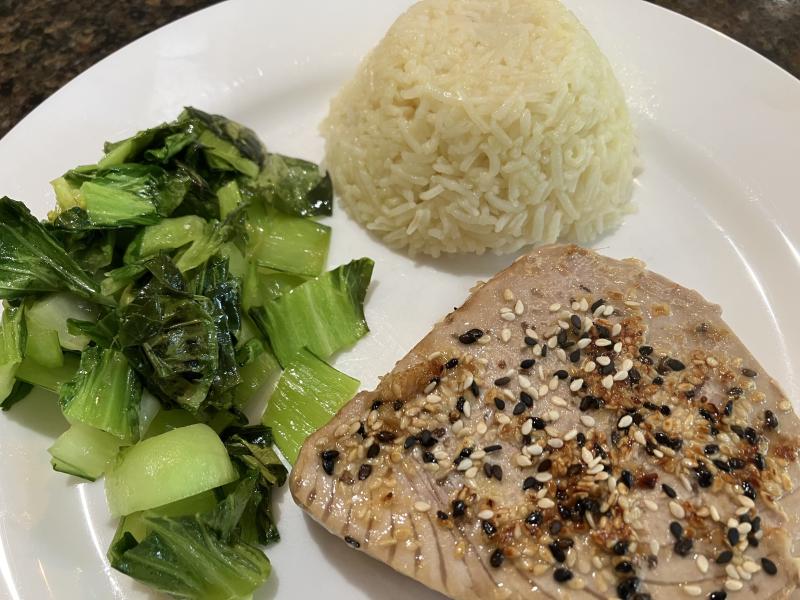Seared, skewered or baked, tuna makes a great main dish
We were in the supermarket looking for a piece of fish to cook for dinner, and most of the options in the “fresh fish” case seemed to have been previously frozen or looked tired and dry, rather than firm and fresh. We checked the freezer case and found most of the choices sealed in plastic bags had been treated with sodium tripolyphosphate, which is used to retain moisture.
We finally came across a package of frozen tuna emblazoned with all sorts of positive statements, such as “wild caught” and “responsible choice.” Once we unpacked the groceries, I did some research to see if we had actually purchased an eco-friendly product. The first thing we found was that Indonesia was listed as the country of origin, which shouldn’t have been a surprise, as it is the largest supplier of tuna in the world at approximately 1 million tons per year.
One of the most encouraging facts to learn about the Indonesian tuna industry is its primary reliance on pole and line or handline techniques, which means less bycatch than commercial longline practices that ensnare sea turtles, sharks and other marine mammals. The only potentially negative aspect of this piece of tuna was the additional ingredient on the label: “carbon monoxide (to retain color).” Why?
Normally, a fresh piece of tuna will begin to lose its red or bright-pink color as soon as it’s exposed to air, and it will become chocolate brown in a few days. If the tuna is treated with carbon monoxide, it will keep its fresh-looking color. If it’s treated and also flash-frozen at the earliest point in the packaging process, the likelihood is better that the color isn’t masking an out-of-date, potentially dangerous piece of fish. Another positive sign on this package was a “sell by” date 18 months in the future.
The specific type of tuna we had purchased was labeled as yellowfin, also called ahi, which grow as large as 300 pounds. Yellowfin flesh is lighter in color than the largest type, bluefin, and darker than the high-fat albacore. The latter is the most popular type available in cans or pouches, precooked and sold packaged in either water or oil.
Anyone who has enjoyed sashimi or a poke bowl is aware that high-quality, fresh tuna can be served raw. There are any number of recipes online for creating an ahi-focused dish from sushi-grade tuna, which needs to be sourced from a reliable supplier in order to be certain it is safe to consume without risk. While I was not going to serve our yellowfin raw, I was comfortable eating it cooked.
If you choose to serve tuna cooked, be sure not to cook it too long, or it can become tough. I’ve included a recipe for the sesame-crusted tuna steak in the photo, plated with steamed bok choi and basmati rice. Marinades can add flavor to your tuna; just make sure not to include any acid (e.g., citrus juice or vinegar) as in the tuna skewer recipe. Another quick-cook tuna option is to bake the steaks just until rare and still pink in the center.
If you’re looking for sushi-grade tuna in this area, you can find it at Lewes Fish House, Big Fish Market and the Fresh Market. All of these suppliers will know the origin of their tuna and can vouch for its freshness. As for our dinner, the tuna was moist and meaty, with a clean flavor that paired nicely with the sesame coating.
Sesame-Crusted Tuna
2 5-oz tuna steaks
1 T soy sauce
1 t toasted sesame oil
3 T sesame seeds
1 t garlic powder
3/4 t salt
1t black pepper
1/2 t sugar
1 t thyme
2 T peanut oil
Pat dry the tuna with paper towels. Brush with soy sauce to coat completely; set aside. Combine toasted sesame oil, sesame seeds, garlic, salt, pepper, sugar and thyme in a small bowl. Coat the tuna with the sesame seed mixture, pressing firmly to make sure it adheres; set aside. Heat a cast-iron skillet over medium high until very hot. Add peanut oil and heat until a drop of water sizzles. Place the tuna steaks in the pan and use a metal spatula to press the tuna into the pan for about 30 seconds; cook for two minutes. Flip the tuna and sear the other side for another two minutes for rare; cook an additional minute for medium rare. Place on a cutting board and slice to serve. Yield: 2 servings.
Baked Tuna Steaks
1 lemon
2 5-oz tuna steaks
2 t olive oil
1/8 t salt
1/2 t pepper
1/4 t garlic powder
1/2 t herbes de Provence
Preheat oven to 450 F. Line a rimmed baking sheet with aluminum foil; set aside. Cut lemon in half; slice one half and cut other half into wedges. Arrange lemon slices on baking sheet. Brush the tuna with olive oil and coat both sides with the salt, pepper, garlic and herbes de Provence. Place tuna steaks directly on the lemon slices. Bake to an internal temperature of 140 F and remove from oven; it will continue cooking to serving temperature in just a few moments. Serve with lemon wedges. Yield: 2 servings.
Grilled Tuna Skewers
1 lb tuna
1 red bell pepper
1 yellow bell pepper
1 red onion
8 mushroom caps
2 T chopped onion
2 garlic cloves
1 T chopped rosemary
1/2 t salt
1/2 t pepper
1/2 C olive oil
Cut the tuna, peppers, and onion into one-inch chunks; set aside. Combine chopped onion, garlic, rosemary, salt and pepper in the bowl of a food processor or blender. Process briefly to purée ingredients. While still processing, slowly pour in olive oil and purée until smooth. Combine tuna and vegetables with marinade; refrigerate for an hour. Preheat grill to high. Thread the vegetables and tuna onto skewers. Cook directly on the grate until lightly browned, about 5 minutes. Turn and brown the other side for another 4 or 5 minutes. Yield: 4 servings.



















































